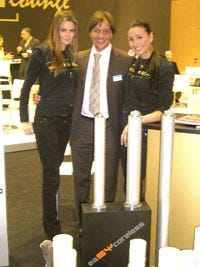NPE highlight: Coreless winding cuts your costs and keeps Wal-Mart happy
Film processors visiting next week’s NPE show absolutely will not want to miss learning more about film winders that employ either thin-walled paperboard cores or even no cores at all. The savings in transport costs are impressive.
June 16, 2009
Film processors visiting next week’s NPE show absolutely will not want to miss learning more about film winders that employ either thin-walled paperboard cores or even no cores at all. The savings in transport costs are impressive.
According to Dave Finnemore, VP sales EMEA (Europe/Middle East/Asia) at film extrusion line manufacturer Gloucester Engineering (Gloucester, MA and Vienna, Austria; Booth S32000 at NPE), the technology’s introduction is being pushed by environmental sensibilities. “The main aims behind developing [film] products with thinner cardboard cores or even with no core at all are reducing costs or removing the need for management and disposal of the used cores, reducing waste taxes, eliminating shipping and storage costs by optimizing film meterage on a pallet, and lowering production costs,” he says.
|
Finnemore says an estimated 350 million cardboard cores are disposed of annually just in Europe, Russia/CIS countries, and the Middle East. While some Central European core suppliers offer collection systems for recycling, in most other regions such schemes don’t exist. He says global multinationals such as Wal-Mart, Coca-Cola, P&G, and the Carrefour group are implementing environmental policies for waste reduction that foresee not accepting hand- and machine-stretch-wrap pallet film if the retailers have to dispose of paperboard cores.
While resin costs for cast stretch film production typically represent 80% of a processor’s total cost, processors of course always are on the outlook for other ways to save, and cores represent one of the latest areas of consideration. Finnemore says in an average inline handwrap production of four 17-µm film reels of 300 m/reel, processors generally use a paper core with a wall thickness of 5 mm. This represents €0.15 or 23.3% of the total conversion cost. Machine film conversion costs of four reels of 23-µm film running 1500m, and assuming a core with wall thickness of 11 mm, will represent an average core cost of €0.42.
But the question remains whether cast film extrusion operations will accept new solutions such as handwrap cores of only 1- to 2-mm wall thickness, and machine film with core wall thickness of only 5 mm or even coreless, Finnemore says, noting, “Reduction in core weight or elimination will ultimately reduce the overall cost per kilogram of film transportation. Wal-Mart CEO Lee Scott reported back in 2007 that the company was pressing vendors to go more ‘green’ and both handwrap and machine wrap were target areas.” Suppliers that deliver to Wal-Mart are being asked to cut their packaging by 5% by 2013.
Finnemore says generally 8360 reels of hand wrap (5-mm wall cores at 300g) fit into an average truck. Using 2-inch cores with a 2-mm wall thickness at 115g, the core weight savings represents 1546 kg per 22 tonnes of film, a potential reduction of 7%. Without cores, an additional 250,800m of film could fit in each truck representing a €0.005/kg reduction in film transport costs.
With machine wrap, by using 3-inch cores with a 5-mm wall thickness at 450g compared to 11-mm wall cores at 1.1 kg, the core weight savings is 858 kg/23 tonnes of film load, where 1320 reels fit into a truck. This represents a 3.67% reduction of transportation weight. The thinner cores would allow 132,000m more of film per truck, for a transport cost savings of €0.003/kg.
Finnemore reckons thin cores are an intermediary step, with the ultimate goal to produce reels of stretch wrap without the need for any cores. His company, along with competitors Collines (Nibbia, Italy), Dolci Extrusion (Milan, Italy; Booth S25056), and SML (Lenzing, Austria; Booth S34072) are all working together with Syncro (Busto Arsizio, Italy; Booth S3010) to develop coreless winding that could be used on existing and new winding equipment. Gabriele Caccia, managing director of Syncro, says the past two years of R&D has produced its latest development, the patented Easycoreless technology introduced at the recent Plast ‘09 show in Milan, which has already been tested and will soon be offered by the partners on new equipment and for retrofitting on installed machines.
The proprietary rotating shafts on the Easycoreless unit have up to 250 expanding and contracting parts to wind, and then deliver a wound film roll from the shaft; they are able to convert to winding with thin-walled cores or regular-thickness cores as well, Caccia says.
Also expected to be talking up the topic at NPE is Canada-based Cooper Machine & Tool (Concord, ON; Booth S14023). The company’s turret coreless winder is said to be fully automatic and winds coreless rolls of perforated tear-off bags at up to 20 cycles/min, claimed to double traditional coreless winder speeds. Operators can adjust the winding width individually on both sides and on the fly. Also, NO.EL Industrial Automation (San Pietro Mosezzo, Italy), as reported in MPW August 2008, plans to import its coreless rewinding equipment to North America. —[email protected]
About the Author(s)
You May Also Like



